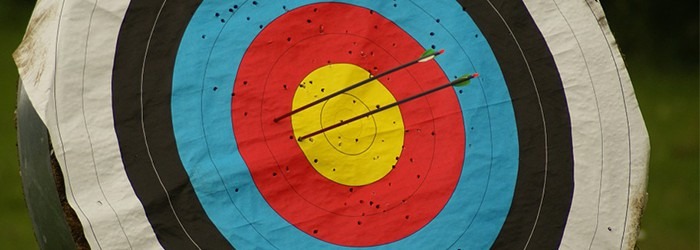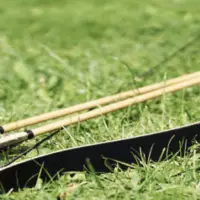This can happen even to the best shot. You draw your bow, perfectly aim and release your arrow, only to find it off to the side. While a one-off shot to the side just might be caused by some human error, a consistent drift should be looked into. In this post, we’re going to explore the main reasons why your shot might go left or right.
The main causes your shot might go left or right:
- Bow torque introduced by the bow hand
- Sight or bow out of tune
- Improper anchoring
- Environmental causes (wind, etc.)
While these causes might sound simple, identifying the actual cause of your arrows drifting to the side can be tricky, and solving the root cause can be quite difficult. Here, we’ll consider everything you need to know to solve the problem. Let’s go!
Reasons why your shot might go off to the side
While fixing your bow shooting off to the side can be quite simple, attending to the root cause is way more important. You may change your bow to account for that, but without knowing what the root cause of the problem is, it’ll always return, and you’ll always have a hard time being consistent.
Bow torque, introduced by your bow hand, can cause your arrows to drift off to the side. This happens when your bow hand is improperly placed on the grip, applying a twisting force. This can cause your bow to rotate, moving your arrows off to the side.
If your bow or sight goes out of tune, it can easily cause your arrows to fly off to the side. For example, if your sight moves even a little left, it’ll cause you to move your bow to the right, causing your arrows to always land right. Some tuning issues in the bow can cause a similar effect.
While improper shooting form typically causes inconsistent shooting, it can cause your arrows to drift off to the side, well grouped or not. The main issue that might result in this is improper anchoring, which might add some side motion to the arrows.
Having bad grouping will make it harder to identify the issues you’re having. You can work to improve your grouping by working on your bow stability, and I’d suggest going about it by first reading my post about bow stability.
The last thing that should also be considered is environmental causes. Is the area you’re shooting in tilted or has hard winds? The terrain can have a direct effect on your performance.
Some of the reasons your arrows are landing on the side might also cause your arrows to go high or low. In a recent article about why your bow is shooting low, I also mentioned some of them, but with specific instructions to prevent your bow from shooting low. If you also have that problem, I suggest reading that post, after you read this one.
Now that we understand, in a general manner, the main issues that might cause your arrows to fly off left or right, we’re ready to dive deeper into every issue, considering the causes and how to solve them.
Bow torque
Torque is a rotational force, that causes objects to rotate along their axes. Bows naturally create torque, and great archers know how to combat it using proper technique. If you fail to handle it, it can easily move your arrows to the side, causing your shots to constantly be off.
The most common causes of bow torque are improper bow grip and out-of-tune equipment. It’s quite easy to recognize: if you’re holding the bow and feeling that it wants to turn, this is probably your problem.
If you’re shooting a compound bow, I would suggest you get your bow check first, because working with equipment that might be out of tune is just ineffective. Recurve bows are less likely to have torque caused by going out of tune.
Eliminating torque is quite simple, and involves checking and improving your grip. I actually wrote an entire post on how to fix your shooting posture, which I’ll definitely recommend, but I’ll shortly detail how proper bow grip should be done:
- Hold your thumb and index finger into an “L” shape, with the other fingers bent.
- Place your hand on the bow’s grip, resting the meaty part of your palm in a natural position.
- Pull the bowstring back, and feel the pressure build.
- Relax your fingers (optional).
- Make sure your wrist sits in a natural position, not being bent in any direction.
Following these steps, you’ll be able to completely eliminate bow torque and fix your bow shooting to the side.
Sight and bow out of tune
Out-of-tune equipment is a common cause of your shots being constantly off. I can almost be any part of the bow or sight, so you can’t really overlook anything. I would actually suggest taking your bow to get tuned in any case if you feel it might be out of tune or tune it yourself if you know how to.
If you’re confident that the issue is with your sight, it might actually be useful to follow my step-by-step bow sight tuning guide.
If you feel like your bow or sight might be out of tune, you might want to paper tune your bow.
How to paper tune your bow
A great way to test whether your bow is out of tune, and actually tune it, is by paper tuning your bow. This is a process where you shoot through a piece of paper and see how to arrow tore through it. If your shooting form is good, this will be the way to check your bow.
To paper tune your bow, all you need are a few pieces of paper, a frame (or something else to hold the paper), your bow and arrows, and a target or a backdrop.
The process of paper tuning is quite simple:
- Attach the piece of paper to the frame, a place it a few close to the target or backdrop (keeping some space between them). Make sure the paper is flat and stable.
- Stand in front of the frame, and shoot an arrow through the paper. Make sure to use proper form and shoot the arrow as level as you can.
- Check how to arrow tore through the paper. If the arrow went straight through the paper you’ll see a center point with symmetrical arms. If the shape tears vertically or to the side, you’ll need to adjust your bow accordingly.
- Try to make small adjustments and repeat the process multiple times to achieve maximal accuracy.
Note that paper tuning will not provide helpful information if your shooting posture isn’t good. If you’re a beginner and you feel your bow might be out of tune, take it to a pro shop and save yourself some time.
Compound bows are actually way more likely to go out of tune than recurve bows. That’s actually one of the major drawbacks of shooting a compound bow, as I’ve covered in my post about compound vs recurve bows.
It’s also interesting to note that single cam compound bows are less likely to go out of tune than dual cam bows, and I’ve covered this and much more in my single cam vs dual cam compound bows comparison post.
Improper anchoring
Anchoring is essential for accurate bow shooting, and it’s one of the main things archers focus on when starting out. Because it’s such an essential step in your shot process, it’s sometimes overlooked.
Improper anchoring can ruin your consistency, and even make your shots go off to the side every time. That typically happens if you’re anchoring, but have some issue with your technique.
If you’re holding the drawing hand too far off to one side, horizontally, your shots might go in the other direction. Most archers use their chin or the side of their mouth as an anchor point, but can still be just a bit off.
To check whether anchoring is your issue, I’d recommend trying to slightly move your anchor point to the direction you shot it off to. If you consistently shoot left, try moving your anchor point a bit left. If you’re shooting right, move it slightly to the right.
Make small adjustments, because they might affect the location of the shot significantly. I would treat it as a process of trying to find the perfect anchor point, which you can start getting used to after you find it.
If you’ve done something a thousand times, it’s only natural to think you’re doing it well. But some archers develop bad habits, either from starting out or over time.
That’s why you should occasionally dissect your shot process and make sure you’re doing everything correctly. So even if you think your anchoring is perfect, try adjusting it and see if you see better results.
Environmental causes
Some environmental causes might have a significant effect on your shots. Wind, tilted ground and more, can be a major cause of issues.
While wind can move your shots quite a bit, it’ll probably move your arrows in a different direction every time, which can be a tell that it, in fact, is the issue.
If you think you’re having trouble because of wind, your options are pretty limited. You can move to a closed range when the weather is harsh, move up closer to the target or learn how to cant your bow (tilt the bow to combat the effect of wind). You can also try shooting heavier arrows, which are less affected by wind.
Now, you might be shooting in some uneven ground, which in hard cases can cause your shots to be off to the side. The ground has to be significantly tilted for that to be the case, though.
Target archers are less likely to face this issue, but if you’re a 3D archer and you’re trying to work on your shot on some specific hard location, this might in fact be the issue.
Sadly, this issue doesn’t have an easy solution as well. To properly shoot in a tilted location, you’ll have to learn bow canting. Luckily, if you’re a 3D archer this is an important skill to have, so you’ll reap the benefit when you work on it.
Conclusions
We’ve covered the common causes of shots being off to the right or left, and the best ways to approach solving the issues. If you’re having this issue, I’d suggest looking into tuning your equipment, and if you still have the issue, try to find the weak spot in the shooting form.
I should add that if this problem frequently repeats, it’s most likely some part of your shooting form and not a tuning issue.
While it’s most likely, in that case, to be your anchoring, if you’re confident you’re doing it properly, I’d try dissecting every part of your shot process by filming yourself and watching the video. Try to make small adjustments and see if anything helps.
I really encourage you to read another post I wrote, which discusses how to solve issues with your arrows going low. It covers the problem in-depth, and it can help you if you’re facing this issue as well.
I hope you’ve found this post helpful, and that you managed to center your shots back. Good luck!




